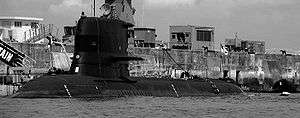Sjöormen-class submarine
 RSS Chieftain | |
| Class overview | |
|---|---|
| Builders: | Kockums |
| Operators: | |
| Preceded by: | Draken class |
| Succeeded by: | Näcken class |
| Planned: | 5 |
| Completed: | 5 |
| Active: | 4 |
| Retired: | 1 |
| General characteristics | |
| Displacement: |
|
| Length: | 50 m (164 ft 1 in) |
| Beam: | 6.1 m (20 ft 0 in) |
| Draught: | 5.1 m (16 ft 9 in) |
| Propulsion: |
|
| Speed: |
|
| Complement: | 23 |
| Sensors and processing systems: | FAS |
| Armament: |
|
The Sjöormen class were a group of submarines built for the Swedish Navy in the late 1960s. They had a teardrop shape and were capable of diving to 150m. At the time of their deployment they were regarded as one of the most advanced non-nuclear submarine-classes in the world, incorporating many new features including x-rudder and anechoic tiles. Both speed and underwater endurance was at this time very high for a conventional submarine. The submarines were retired by Sweden in the early 1990s. In the late 1990s, four submarines were acquired by the Republic of Singapore Navy and relaunched as the Challenger class following modernisation and tropicalisation.[1][2]
Ships
| Ship Name | Builder | Launched | Commissioned | Status |
|---|---|---|---|---|
| HMS Sjöormen | Kockums | 25 Jan 1967 | 31 July 1968 | sold to Singapore as RSS Centurion |
| HMS Sjölejonet | Kockums | 29 June 1967 | 16 Dec 1968 | sold to Singapore as RSS Conqueror |
| HMS Sjöbjörnen | Karlskrona Navy yard | 9 Jan 1968 | 28 Feb 1969 | sold to Singapore as RSS Challenger |
| HMS Sjöhunden | Kockums | 21 March 1968 | 25 June 1969 | sold to Singapore as RSS Chieftain |
| HMS Sjöhästen | Karlskrona Navy yard | 6 Aug 1968 | 15 Sept 1969 | sold to Singapore as spare parts |
References
- Notes
- ↑ "Dr Tan Launches First Submarine in Sweden". Ministry of Defence Singapore. Retrieved 2012-12-06.
- ↑ "Submarine Tropicalisation Programme". MINDEF. Retrieved 2012-12-06.
- Bibliography
- Conway's All the World's Fighting Ships 1947-1995
External links
This article is issued from Wikipedia - version of the 10/31/2016. The text is available under the Creative Commons Attribution/Share Alike but additional terms may apply for the media files.